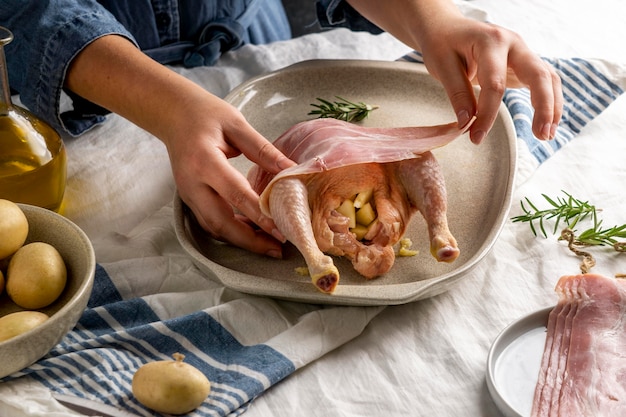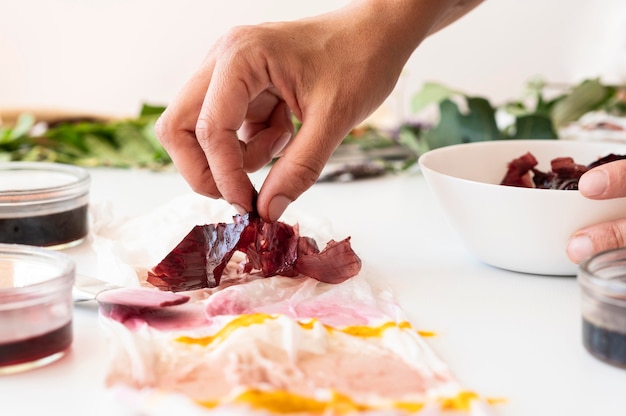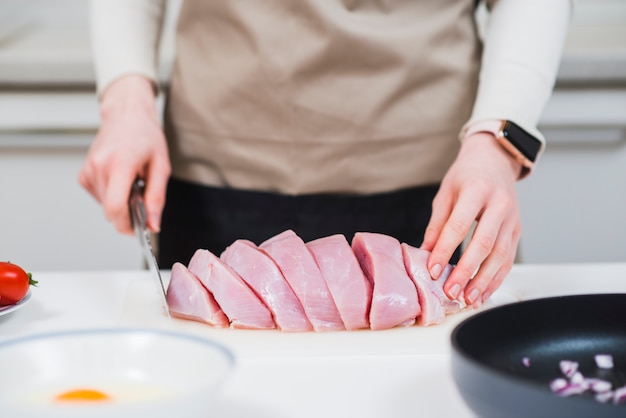Let's face it, there's nothing quite like a good ham. Whether it's a holiday feast or a casual weeknight dinner, ham is a crowd-pleaser that always hits the spot. But what about those leftovers? Reheating a ham can be tricky. You don't want to dry it out or end up with a rubbery mess.
I've been there, folks. I've had my fair share of reheating mishaps. But over the years, I've learned a thing or two about getting this right. So, grab a cuppa, settle in, and let's explore the world of ham reheating together.
Part 1: Knowing Your Ham: A Culinary Detective's Guide

First things first, we need to get to know our ham. Think of it like a culinary detective case - we need to gather all the clues to solve the reheating mystery.
1. Bone-in vs. Boneless: A Case of the Missing Bone
The presence or absence of a bone can significantly impact the reheating process. bone-in hams, you see, are a bit more complex. That bone acts like a heat sink, slowing down the heating process. Imagine the bone as a tiny, bone-shaped ice cube in the middle of your ham. It takes longer for the heat to melt that "ice cube" and reach the center.
boneless hams, on the other hand, are a bit more straightforward. There's no bone to get in the way, so the heat penetrates faster and more evenly.
2. Spiral Sliced vs. whole ham: The Shape of the Mystery
The shape of your ham is another important clue. spiral-sliced hams are like a gift from the culinary gods - they're already sliced, making it a breeze for the heat to reach every corner. It's like having little doors open for the heat to easily penetrate.
Whole hams, however, are a different story. Those big, unyielding blocks of meat require a bit more patience and strategy. The heat has to travel through the entire piece, which takes longer and can be tricky to do evenly.
Part 2: The Reheating Methods: Unveiling the Culinary Secrets

Now that we've got the lay of the land with our ham, it's time to choose our reheating method. Each method has its own strengths and weaknesses. Think of it as a culinary buffet - a variety of options to suit your taste and needs.
1. The Oven: Classic and Reliable, But Not Always Perfect
The oven is like the trusty old friend of the kitchen - it's always there, reliable and dependable. Simply preheat your oven to 325°F (160°C) and place your ham in a roasting pan. A little bit of water in the pan helps to keep the ham moist and prevents it from drying out. The ham is ready when it reaches an internal temperature of 140°F (60°C).
But here's the thing: I've found that reheating a whole ham in the oven can be a bit tricky. The outer edges can end up overcooked while the center remains stubbornly cold. It's like trying to warm a giant rock - the outside gets hot quickly, but the inside takes forever to catch up.
Reheating Time: A Rough Guide
Here's a rough guide to help you estimate the reheating time for a whole ham in the oven, but remember, these are just estimates, and you'll need to use a meat thermometer to ensure your ham is cooked through.
| Ham Size (pounds) | Reheating Time (minutes per pound) |
|---|---|
| 4-6 | 15-20 |
| 7-10 | 20-25 |
| 11-14 | 25-30 |
The oven is great for larger hams, but it does require some careful monitoring to make sure everything cooks evenly.
2. The slow cooker: The Gentle Touch for Tender Ham
The slow cooker, my friends, is a champion of gentle reheating. It's like a culinary hug for your ham. Simply place your ham in the slow cooker, add a splash of liquid like chicken broth or apple juice, and cook on low for 2-3 hours, or until the internal temperature reaches 140°F (60°C). The slow cooker's gentle warmth ensures a moist and tender ham. It's like a spa day for your ham, leaving it feeling relaxed and rejuvenated.
Pro Tip: I'm a big fan of adding a cup of apple cider to the slow cooker. It gives the ham a touch of sweetness and a lovely aroma. It's like giving your ham a little bit of apple-scented aromatherapy.
3. The Microwave: Quick and Convenient, but Be Careful
The microwave is like the quick-fix solution of the kitchen. It's great for reheating small portions of ham in a pinch. But be careful, my friend! The microwave can be a bit of a hothead, and it's easy to overcook the ham. Cover the ham with a damp paper towel to prevent drying out and microwave on high for 30-60 seconds per pound.
Important Note: Never try to reheat a whole ham in the microwave. It's like trying to fit a whole elephant in a small car. The ham will be unevenly heated and probably dry out. Stick to smaller portions for microwave reheating.
4. The Stovetop: Simple and Versatile
The stovetop is a great option for reheating ham in a skillet. Think of it as a quick and easy, "I'm-in-a-hurry" solution. Heat some butter or oil in a skillet over medium heat and add the ham slices. Cook for 2-3 minutes per side, or until heated through.
Tip: Add a little water to the skillet to keep the ham moist. You can also add some seasonings like garlic powder or paprika for an extra flavour kick.
Part 3: Reheating Dos and Don'ts: Navigating the Culinary Minefield

Now that you've learned about the various reheating methods, it's time to navigate the minefield of dos and don'ts. These rules are your safety net to ensure you end up with a perfectly reheated ham, not a culinary disaster.
1. Do: Use a Meat Thermometer - Your Culinary Guardian Angel
A meat thermometer is your culinary guardian angel. It's the only way to guarantee that your ham has reached a safe internal temperature of 140°F (60°C).
2. Do: Cover the Ham - Keeping It Cozy
Covering the ham during reheating is like giving it a warm, cozy blanket. It helps retain moisture and prevents it from drying out. You can use aluminum foil, parchment paper, or a lid.
3. Do: Add Liquid - A Splash of Moisture
Adding a splash of liquid to the roasting pan or slow cooker is like giving your ham a refreshing drink of water. It helps keep the ham moist. You can use water, chicken broth, apple juice, or even beer.
4. Don't: Overcook the Ham - It's a Delicate Dance
Overcooking is like a culinary crime. It can turn a delicious ham into a dry, rubbery mess. Watch the internal temperature carefully and remove the ham from the heat as soon as it reaches 140°F (60°C). Remember, it's a delicate dance, not a brute force operation.
5. Don't: reheat ham Multiple Times - One and Done
Reheating ham multiple times is like giving it a culinary workout that it's not ready for. It can lead to foodborne illness. It's best to reheat the ham only once and enjoy it within a few days. Think of it as a one-time performance, not a marathon.
Part 4: Serving Up Your Reheated Ham: A Culinary Masterpiece
So, you've reheated your ham to perfection. Now it's time to create a culinary masterpiece! Here are a few ideas to showcase your beautifully reheated ham:
1. The Classic Ham Feast: A Timeless Delight
For a classic ham feast, simply slice the reheated ham and serve it alongside some sides. It's like a culinary symphony of flavours. Some popular sides include baked beans, mac and cheese, potato salad, and cornbread. You can also add some sliced pineapple or fruit salad for a touch of sweetness.
2. The Ham Sandwich: A Crowd-Pleaser for Any Occasion
ham sandwiches are a quick and easy way to use up leftover ham. They're like a blank canvas for your culinary creativity. Simply slice the ham and put it between two slices of bread with your favourite fillings. Some popular fillings include mustard, mayonnaise, lettuce, and tomato.
I'm a big fan of adding a little bit of Swiss cheese and a pickle to my ham sandwiches. It adds a nice touch of tangy flavour.
3. The ham soup: A Cozy Comfort for Cold Days
If you're looking for a more creative way to use leftover ham, try making ham soup. It's like a warm hug in a bowl. Simply add some chopped ham to a pot of vegetable broth with potatoes, carrots, onions, and other vegetables. Season with salt, pepper, and herbs to taste.
4. The ham pizza: A Culinary Fusion Adventure
For a fun and delicious twist on pizza, try topping your favourite crust with ham, cheese, and your favourite toppings. It's like a culinary fusion adventure. This is a great way to use up small amounts of leftover ham.
Fun Fact: Did you know that ham is actually a versatile ingredient in many cuisines? In Asia, it's often used in stir-fries and noodle dishes.
Part 5: Storage and Leftovers: Making the Most of Your Ham
You've got your reheated ham, but what about the leftovers? Don't let those precious bits of ham go to waste! Here's how to store and use them wisely.
1. Store It Properly - Keep It Fresh
Leftover ham should be stored in the refrigerator in an airtight container. Think of it as a culinary safe deposit box. It's best to use it within 3-4 days to ensure it stays fresh and delicious.
2. Freeze It for Later - A Culinary Time Capsule
If you have a lot of leftover ham, you can freeze it for later use. Place it in an airtight container or freezer bag and freeze for up to 2 months. It's like putting your ham in a culinary time capsule, ready to be enjoyed later.
3. Thaw It Safely - No Room for Foodborne Illnesses
To thaw frozen ham safely, transfer it from the freezer to the refrigerator and allow it to thaw overnight. Never thaw ham at room temperature - it's a recipe for foodborne illness. Remember, safety first!
Part 6: The Nutritional Value of Ham: A Balanced Look
Ham is a good source of protein, but it's also high in sodium and fat. It's like a culinary double-edged sword. If you're watching your weight or sodium intake, you might want to eat ham in moderation.
1. Protein Powerhouse - Fuel for Your Body
Ham is a great source of protein, which is essential for building and repairing tissues. A 3-ounce serving of ham provides about 15 grams of protein. It's like a little protein boost for your body.
2. Sodium Alert - Be Mindful of Your Intake
Ham is also high in sodium. A 3-ounce serving of ham can contain up to 1,000 milligrams of sodium. If you're watching your sodium intake, it's best to choose leaner cuts of ham and eat them in moderation. Remember, everything in moderation!
3. Fat Content - A Balanced Approach
Ham contains a moderate amount of fat. While fat is important for energy and hormone production, too much fat can lead to weight gain and other health problems. It's like the classic culinary balancing act - enjoy ham, but be mindful of your overall fat intake.
Part 7: FAQs: The Answers You Need
Here are some frequently asked questions about reheating fully cooked ham. Let's clear up any lingering mysteries and give you the knowledge you need for a successful ham reheating adventure.
1. How do I know if my ham is fully cooked?
Fully cooked ham is already safe to eat, but it's important to reheat it properly to ensure it reaches a safe internal temperature of 140°F (60°C). It's like giving your ham a final check-up to make sure it's in tip-top shape.
2. Can I reheat ham in the slow cooker with the bone in?
Yes, you can reheat ham with the bone in the slow cooker. Just make sure to add enough liquid to cover the bottom of the slow cooker. The bone will help to distribute heat evenly and keep the ham moist. It's like having a built-in heat diffuser.
3. Can I reheat ham in the instant pot?
Yes, you can reheat ham in the Instant Pot. Use the "Manual" setting and cook on high pressure for 5-10 minutes, depending on the size of the ham. Let the pressure release naturally for 10 minutes before releasing the remaining pressure manually. It's like a quick and efficient culinary shortcut.
4. Can I reheat ham on the grill?
Yes, you can reheat ham on the grill. Simply place the ham on the grill over medium heat and cook for about 5-10 minutes, or until heated through. It's like giving your ham a little barbecue makeover.
5. How long can I keep leftover ham in the refrigerator?
Leftover ham can be stored in the refrigerator for 3-4 days in an airtight container. Think of it as a culinary countdown - enjoy it within those 3-4 days for optimal freshness and flavour.
Part 8: Conclusion: The Reheated Ham Adventure Awaits
There you have it, my friends! I hope this ultimate guide has equipped you with the knowledge and confidence to reheat your fully cooked ham with ease. Remember, reheating a ham is like a culinary adventure. With a little knowledge, planning, and attention to detail, you'll be able to create a delicious and satisfying meal that everyone will love. So go forth, embrace the adventure, and enjoy your perfectly reheated ham! Happy eating!
Everyone is watching

Prime Rib Roast Cooking Time Chart: Per Pound Guide
Cooking TipsPrime rib roast. Just the name conjures images of lavish dinners, crackling fires, and hearty laughter. It’s ...

How Long to Bake Potatoes in the Oven (Perfect Every Time)
Cooking TipsBaked potatoes are a staple in my kitchen. They're incredibly versatile, delicious, and surprisingly easy to m...

Perfect Rice Every Time: The Ultimate Guide to Cooking Rice
Cooking TipsAs a self-proclaimed foodie, I've always been a bit obsessed with rice. It's the foundation of countless cuisi...

The Ultimate Guide to Cooking Asparagus: Tips, Techniques, and Recipes
Cooking TipsAsparagus. The mere mention of this spring delicacy conjures up images of vibrant green spears, crisp and burs...

Ultimate Guide to Cooking the Perfect Thanksgiving Turkey
Cooking TipsThanksgiving. Just the word conjures up images of overflowing tables laden with delicious food, the scent of r...
